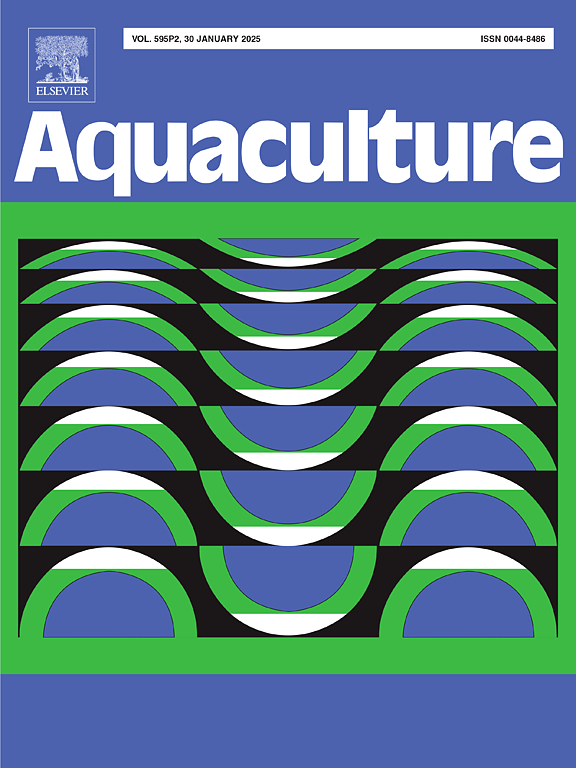Performance of Atlantic salmon reared under three different regimes of continuous aerobic exercise during the freshwater phase
IF 3.9
1区 农林科学
Q1 FISHERIES
引用次数: 0
Abstract
Freshwater rearing conditions influence the growth and seawater adaptation of Atlantic salmon, and swimming exercise may enhance these adaptive processes. This study examined growth and physiological responses of Atlantic salmon subjected to continuous swimming at three speeds: low (0.5 body length per second, BL/s) and moderate (1.0 and 1.5 BL/s) for 11 weeks in freshwater, followed by transfer to brackish water. Fish trained at 1.0 and 1.5 BL/s demonstrated significantly higher specific growth rates and plasma insulin-like growth factor 1 levels after 5 weeks in brackish water, suggesting that moderate exercise enhances growth. Additionally, the 1.5 BL/s group showed a higher frequency of small-diameter white muscle fibers, suggesting hyperplastic growth. Although the expression of growth-related genes was not affected by swimming speed, moderate exercise groups had significantly lower plasma triglycerides and cholesterol levels, suggesting a shift of energy allocation towards growth. At the end of the freshwater phase, distinct energy allocation strategies were evident: the low-speed swimming group had higher hepatosomatic index and plasma inorganic phosphate levels, whereas the 1.5 BL/s group showed higher muscle adenylate energy charge, indicating enhanced muscle energy status. Fish in moderate swimming groups also had lower cortisol, creatinine (significantly different between 0.5 and 1.5 BL/s), and lactate levels (significantly different between 0.5 and 1.0 BL/s), suggesting an improved stress profile. Swimming exercise did not affect smoltification markers, including NKA activity or plasma sodium and chloride concentrations. Overall, moderate swimming (1.0–1.5 BL/s) improved growth in Atlantic salmon, highlighting potential applications for aquaculture.
淡水阶段在三种不同的连续有氧运动下饲养的大西洋鲑鱼的生产性能
淡水养殖条件影响大西洋鲑鱼的生长和海水适应,而游泳运动可以增强这些适应过程。本研究研究了大西洋鲑鱼在淡水中以低(0.5体长/秒)和中(1.0和1.5体长/秒)三种速度连续游泳11周,然后转移到半咸淡水中的生长和生理反应。以1.0和1.5 BL/s训练的鱼在半咸淡水中训练5周后,其特定生长率和血浆胰岛素样生长因子1水平显著提高,这表明适度运动可以促进生长。此外,1.5 BL/s组出现小直径白色肌纤维的频率较高,提示增生生长。虽然生长相关基因的表达不受游泳速度的影响,但适度运动组的血浆甘油三酯和胆固醇水平显著降低,这表明能量分配向生长转移。在淡水期结束时,不同的能量分配策略是明显的:低速游泳组有更高的肝体指数和血浆无机磷酸盐水平,而1.5 BL/s组有更高的肌肉腺苷酸能量电荷,表明肌肉能量状态增强。适度游泳组的皮质醇、肌酐(显著差异在0.5 ~ 1.5 BL/s之间)和乳酸水平(显著差异在0.5 ~ 1.0 BL/s之间)也较低,表明应激状况有所改善。游泳运动不影响smoltification标志物,包括NKA活性或血浆钠和氯浓度。总体而言,适度游泳(1.0-1.5 BL/s)改善了大西洋鲑鱼的生长,突出了水产养殖的潜在应用。
本文章由计算机程序翻译,如有差异,请以英文原文为准。
求助全文
约1分钟内获得全文
求助全文
来源期刊

Aquaculture
农林科学-海洋与淡水生物学
CiteScore
8.60
自引率
17.80%
发文量
1246
审稿时长
56 days
期刊介绍:
Aquaculture is an international journal for the exploration, improvement and management of all freshwater and marine food resources. It publishes novel and innovative research of world-wide interest on farming of aquatic organisms, which includes finfish, mollusks, crustaceans and aquatic plants for human consumption. Research on ornamentals is not a focus of the Journal. Aquaculture only publishes papers with a clear relevance to improving aquaculture practices or a potential application.
 求助内容:
求助内容: 应助结果提醒方式:
应助结果提醒方式:


